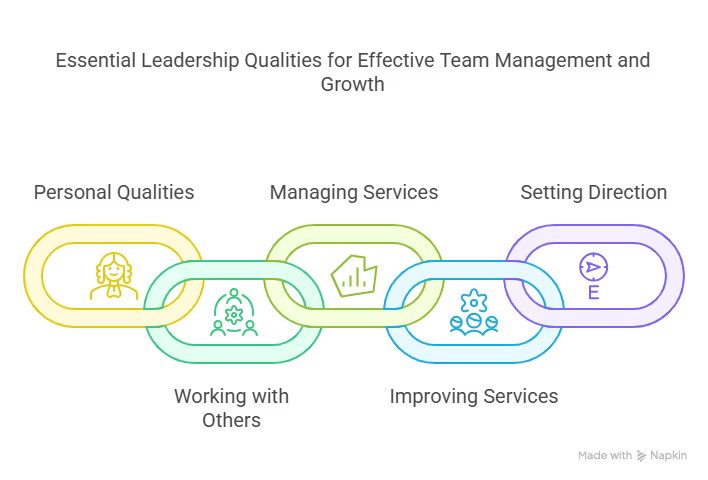
Have you ever worked with someone who made everything feel more organised, calmer, and fairer, even on the busiest days? In health and social care, strong leadership shapes the entire experience for both staff and service users. According to Skills for Care, services with effective leaders see better outcomes and improved team wellbeing. That’s why understanding and developing leadership qualities is essential.
The Leadership Qualities Framework outlines the key behaviours, values, and skills needed to lead effectively in health and social care. It helps individuals grow into confident, capable leaders who can guide teams and improve services.
In this blog, you’ll learn what the framework includes, how it works, and how to use it in your own leadership journey—whether you’re just starting or already leading a team.
Purpose of the Leadership Qualities Framework
The Leadership Qualities Framework exists to give structure to how we understand leadership in health and social care. It helps you see what good leadership looks like at different levels, from new supervisors to senior managers. With it, you can focus on behaviours that actually improve care and support teams.
You might already be showing some leadership skills without realising it. The framework helps you recognise those strengths and build on them. It’s not about job titles, it’s about how you lead in practice.
It also creates a shared language across teams. When everyone understands the same expectations, it’s easier to work together, spot gaps, and raise standards.
Lastly, the framework supports reflection and development. Whether you’re reviewing your own progress or helping someone else grow, it gives you a clear and practical guide to follow.
5 Core Leadership Qualities Within the Framework
The Leadership Qualities Framework breaks effective leadership into five core areas. These qualities are essential for delivering consistent, person-centred care and supporting team wellbeing. Whether you’re new to a leadership role or have years of experience, understanding these areas gives you a practical base for reflection and improvement.

Personal Qualities
Good leadership starts with who you are. Being honest, self-aware, and calm under pressure helps build trust and stability. When your team sees that you take responsibility for your actions and remain professional, even in challenging situations, they feel supported.
Leaders also need to recognise their own limits. It’s important to ask for help, reflect on feedback, and stay open to learning. This kind of self-awareness makes you more approachable and easier to work with.
Working with Others
You can’t lead well without building strong relationships. This means listening carefully, sharing information clearly, and respecting the views of others. Teams function better when communication is open and consistent.
Leaders should encourage collaboration across roles and services. In health and social care, this includes working closely with families, health professionals, and colleagues. When people feel heard and involved, they’re more likely to stay engaged and motivated.
Managing Services
A big part of leadership is making sure services run safely and smoothly. This includes planning staff rotas, managing resources, and ensuring care meets expected standards. You need to stay organised and make decisions based on what’s best for both staff and service users.
It also involves being prepared for problems. A strong leader knows how to respond quickly to issues, communicate clearly during a crisis, and take responsibility for fixing things.
Improving Services
Good leaders are always looking to do better—not just maintain the status quo. This means using feedback, audits, or complaints as opportunities to learn. Small, steady changes can make a big difference over time.
You also support your team by encouraging learning. Helping others grow in their roles creates a more skilled and confident workforce, which improves the quality of care.
Setting Direction
Leaders must give their team a clear sense of purpose. This involves setting goals that are realistic, measurable, and understood by everyone. When your team knows what they’re working towards, they stay focused and more motivated.
It’s also important to explain why things matter. Helping others see the bigger picture—how their role impacts the lives of service users—creates a shared sense of value and commitment.
Together, these five areas shape leadership that is thoughtful, effective, and grounded in everyday practice. They help you lead not just with skill, but with care, purpose, and consistency.
Health and Social Care Level 3 Diploma
Benefits of Using the Framework
Using the Leadership Qualities Framework offers practical advantages for both individuals and teams. Here are the key benefits in simple terms:
- Clear direction
It shows you what good leadership looks like, helping you focus on the right behaviours and values. - Supports self-reflection
You can assess your strengths and identify areas where you can grow with confidence. - Improves consistency
When everyone follows the same standards, teams work more smoothly and communication improves. - Boosts personal development
It helps you set realistic goals and track your progress in leadership skills. - Strengthens team supervision
Managers can use it during appraisals to give fair, useful feedback and set shared goals. - Enhances service quality
With better leadership, staff feel supported—and service users receive more consistent, high-quality care.
FAQs
What are the 4 frameworks of leadership in organisations?
The four common leadership frameworks are Structural, Human Resource, Political, and Symbolic. Each focuses on a different way leaders understand and manage teams, challenges, and goals within an organisation.
What are the 7 C’s of leadership?
The 7 C’s of leadership are: Clarity, Courage, Competence, Commitment, Compassion, Communication, and Character. These qualities help leaders guide others effectively while building trust and respect.
What are the frameworks of leadership?
Leadership frameworks provide structured approaches to guide how leaders behave, make decisions, and support others. They often include qualities like emotional intelligence, collaboration, ethical practice, and the ability to lead change.
What is the NHS Leadership Qualities Framework?
The NHS Leadership Qualities Framework outlines the behaviours, values, and skills expected of leaders across the health and care sector. It helps individuals reflect, grow, and lead in ways that improve both staff experience and patient care.
7. Final Words
The Leadership Qualities Framework gives clear, practical guidance for anyone in a leadership role within health and social care. It helps leaders grow, support their teams, and improve care through everyday actions.
As leadership expert Professor Michael West says, “Compassionate leadership is not a soft skill—it’s the key to high-quality care.” By using this framework, you lead with clarity, consistency, and care—exactly what the sector needs most.